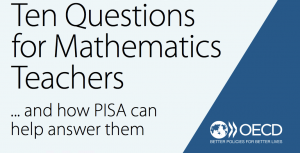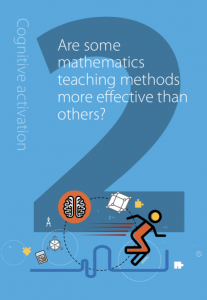 In this episode, we continue to tackle the huge PISA report found at…
In this episode, we continue to tackle the huge PISA report found at…
http://www.oecd.org/publications/ten-questions-for-mathematics-teachers-and-how-pisa-can-help-answer-them-9789264265387-en.htm
We focus on Question #2: Are some mathematics teaching methods more effective than others? Really, this episode focuses specifically on cognitive-action strategies. What are they? How effective are they? When should they be used?
If you have any questions, comments, or suggestions, please contact us on Twitter: Maggie (@pelelover1) and Duane (@dhabecker)
Maggie and Duane continue digging into the OECD report “Ten Questions for Mathematics Teachers…and how PISA can help answer them.”
You can download their report here…
Today’s Question is Question #2: Are some mathematics teaching methods more effective than others?
What we will find is that this chapter seems to focus on Cognitive Activation.
First a little intro: The role of a teacher is exhausting. We make thousands of decisions daily. We are bombarded by emails, meetings, report cards, committees…oh…AND we teach! Because of this “putting out the next fire” reality, teachers are rarely afforded the opportunity of taking a step back and reflecting on whether the teaching methods they are using are really the best for student learning. It’s time for all of us to stop and think.
As the previous chapter discusses, using a variety of teaching strategies is particularly important when teaching mathematics to students with different abilities, motivation and interests. But student data indicate that, on average across PISA-participating countries, the use of cognitive-activation strategies has the greatest positive association with students’ mean mathematics scores.1
Cognitive-activation strategies give students a chance to think deeply about problems, discuss solution methods and mistakes with others, and reflect on their own learning.
WHAT IS COGNITIVE ACTIVATION IN MATHEMATICS TEACHING?
Cognitive activation is, in essence, making the students do the heavy lifting/heavy thinking. It is about teaching pupils strategies, such as summarizing, questioning and predicting, which they can call upon when solving mathematics problems.
Some of these strategies will require pupils to link new information to information they have already learned, apply their skills to a new context, solve challenging mathematics problems that require extended thought and that could have either multiple solutions or an answer that is not immediately obvious.
These strategies enhance learning and lead to a deeper understanding of the concepts. They encourage students to think more deeply to find solutions and focus on the method they used instead of just answer getting.
HOW WIDELY USED ARE COGNITIVE-ACTIVATION STRATEGIES?
The good news is that, across countries, cognitive-activation strategies are frequently used in mathematics teaching. The most commonly cited cognitive-activation strategy – the teacher asking students to explain how they solved a problem – was reported by 70% of the students as occurring in most lessons.
Examples of cognitive-activation strategies are remarkably mundane and commonplace teacher moves.
- The teacher asks students to decide on their own procedures for solving complex problems
- The teacher presents problems for which there is no immediately obvious method of solution
- The teacher gives problems that require students to think for an extended time
- The teacher presents problems in different contexts so that students know whether they have understood the concepts
- The teacher asks questions that make students reflect on the problem
- The teacher gives problems that can be solved in several different ways
- The teacher helps students learn from mistakes they have made
- The teacher presents problems that require students to apply what they have learned to new contexts
- The teacher asks students to explain how they have solved a problem
Since cognitive-activation strategies themselves are not earth-shattering, perhaps what we should take from this is the need for teachers to deliberately do these things.
HOW CAN THE USE OF COGNITIVE-ACTIVATION STRATEGIES BENEFIT STUDENT ACHIEVEMENT?
Students who reported that their teachers use cognitive-activation strategies in their mathematics classes also have higher mean mathematics scores on the PISA. When we take into account teachers’ use of other teaching strategies in the students’ mathematics classes, the strength of the relationship between cognitive-activation teaching and student achievement is even stronger.
The use of cognitive-activation teaching strategies makes a difference no matter how difficult the mathematics problem. In fact, the odds of student success are even greater for more challenging problems. Students who are more frequently exposed to cognitive-activation teaching methods are about 10% more likely to answer easier items correctly and about 50% more likely to answer more difficult items correctly.
In our last podcast episode where we discussed teacher-directed versus student-directed classrooms, we learned that teacher-directed was more successful with low-level questions, while student-directed instruction benefitted students the most with high-level questions.
In this episode, we learn that cognitive-activation strategies benefit students no matter the difficulty of the problems.
IN WHAT ENVIRONMENT DOES COGNITIVE ACTIVATION FLOURISH?
Socio-economically advantaged students reported more exposure to these strategies than disadvantaged students; and when cognitive-activation strategies are used, the association with student performance is stronger in advantaged schools than in disadvantaged schools.
If these strategies are so beneficial, why isn’t every teacher using them more frequently? PISA data suggest that certain school and student characteristics might be more conducive to using cognitive-activation strategies. These types of teaching strategies emphasize thinking and reasoning for extended periods of time, which may take time away from covering the fundamentals of mathematics.
Thus, using cognitive-activation strategies might be easier in schools or classes in which students don’t spend as much time focusing on basic concepts.
Student behavior in the classroom also impacts a teacher’s ability to use cognitive-activation strategies with students.
The OECD teacher survey, TALIS, also suggests that teachers who collaborate with their colleagues are more inclined to then incorporate cognitive-activation strategies in the classroom.
WHAT CAN TEACHERS DO?
- Use cognitive-activation strategies.
- these strategies related to improved student achievement for problems of all levels of difficulty
- students should be able to learn from their mistakes, work together, and reflect on problems
- Find ways to use cognitive-activation strategies in all of your classes.
- Ensure a positive learning environment in your classroom, so that you can then use cognitive-activation strategies
- Let students work in small groups
- Look at what the research says about how students best learn mathematics.
- Enrich your current teaching strategies by reading new research
- Collaborate with other teachers.
- Doing so increases the likelihood that you will use cognitive-activation strategies in the classroom.
The big take away: Learning mathematics should not be a passive endeavor. Teachers can activate student thinking simply by asking provocative questions, allowing students to struggle, and encouraging students to explain their thinking.
Let’s get on it.
.
.
.
